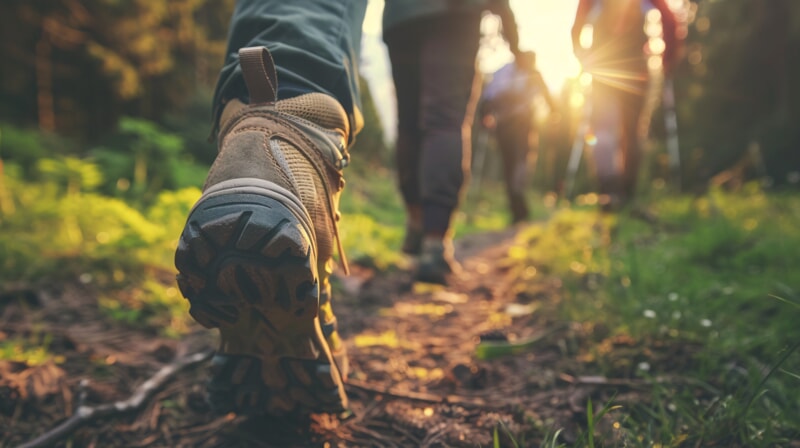
Oklahoma City’s metro area is a hiker’s paradise, with at least 90 miles of scenic views across 10 interconnected trails. Some are wheelchair friendly, but most are multi-use paved paths. When you have had enough of these, travel further out and enjoy the panoramic views of the hundreds of hiking trails and parks across Oklahoma.
Read on for the trail description of the magnificent trails and parks in Oklahoma City, OK.
Top Hiking & Trails in Oklahoma City, OK
Lake Hefner Trail: This is one of the lakeside trails in Oklahoma City. It is 33m (108ft) elevation. The loop trail is 15.1km( 9.4 miles) and takes an average of 2 hrs 46 minutes to complete. The views include Lake Hefner and forests.
Bluff Creek Trail: This moderate trail loop is 3.9 miles (6.1km) long and easy to navigate, whether walking or running. The elevation gain is about 24m (78ft), a favorable climb for beginners and seasoned hikers. It is a multi-use trail popular with bikers and hikers who wish to enjoy an outdoor adventure.
Oklahoma River Trail: The multi-use paved path along the Oklahoma River is popular with those seeking a long trail (23km/14.3 miles) with scenic views of rivers. It takes a little over 4 hours to complete this trail, which is 65m (213ft) high.
Top Parks to Explore in Oklahoma City, OK
Scissortail Park: This is one of Oklahoma City’s newest parks, offering an outdoor experience on a 70-acre oasis. It has ornamental gardens, woodlands, dirt trails, a lake, a dog park, a restaurant, a seasonal rink, and a picnic grove.
Martin Park Nature Center is an expansive 144-acre park with 2.5 miles of hiking trails through mature woodlands, creeks, and grasslands. It also has playgrounds for kids and is wheelchair-friendly.
Myriad Botanical Gardens: The park has a 17-acre botanical garden with plants from across the globe. It offers a calming outdoor experience for hundreds of people. The Myriad Gardens Perimeter Walk (1km/0.6 miles) is one of the magnificent trails in this park and has an elevation of 5m. There are also dirt trails for biking.
Hidden Gems to Interact With Nature Around OKC
Lake Overholser: This popular water reservoir is loved by boaters and those looking for picnic spots in West Oklahoma. Views include sunsets, migrating birds from Stinchcomb Wildlife Refuge, and duck ponds. Facilities include boat ramps and fishing piers. Nature trails, like the Hefner-Overholser trail, are popular.
Spring Creek Trail: The ascent trail is 7.7km (4.8km) long and has a 48m elevation gain. The trail surface is fully paved, but it is a challenging trail for wheelchair users and those new to hiking. Views include forest trails and birds.
SCIP Recreation Trail: It is an easy loop trail, 8.2km (5.1 miles) long, with a 37m elevation gain. You’ll encounter a few hikers and bikers, so it is a perfect choice if you’re looking for deserted multi-use dirt trails. Views include a wildflower habitat and forest.
Discover the Nature of OKC, No Matter Your Fitness Level
Oklahoma has great inspirational opportunities to get fit, even for people who don’t enjoy outdoor adventure. The views and moderate trails will leave you yearning for an outdoor experience. All you have to do is start your fitness journey.
Bluff Creek Park Trail, Bert Cooper Loop, and Lighthouse at East Wharf Trail are moderate hiking trails that take about half an hour to complete. Seasoned hikers can explore longer trails, like the Oklahoma River Trail, a 14-mile moderately trafficked trail.
Fit hikers can attempt a difficult trail with high elevation gain. An example is the 10-mile trail, Skyline Trail, with a 487m (1600ft)elevation gain. If you’re unsure of your fitness level, you can start with a moderate-level trail and progress to a challenging trail.
Protecting and Preserving OKC’s Natural Beauty with Professional Tree Care
Monster Tree of Greater Oklahoma City understands the value of trees for hikers as they explore the nature trails across the different parks in Oklahoma. The trees:
Keep the environment cool.
Absorb pollutants, especially on trails within the city.
Protect wildlife.
Provide oxygen to hikers, especially for trails with high elevation gains.
Provide shade along forest trails and lakeside trails.
Prevent soil erosion.
Provide food for wildlife.
Reduce noise.
Hikers can help by identifying diseased trees or those with exposed roots that make mountain biking trails risky. We trim and prune trees to keep them from overgrowing onto the draper trails. Our teams also monitor the trees for signs of diseases and insect invasion to keep them from spreading to other trees.
